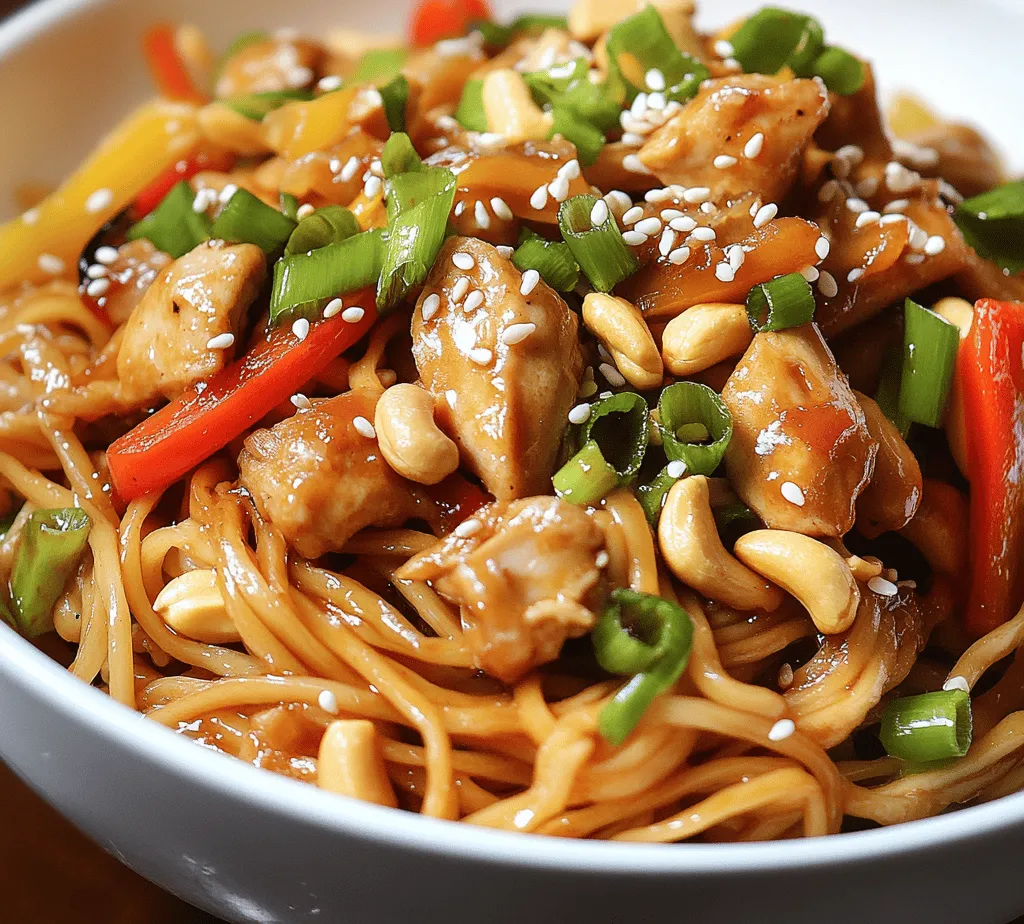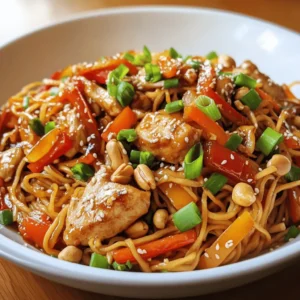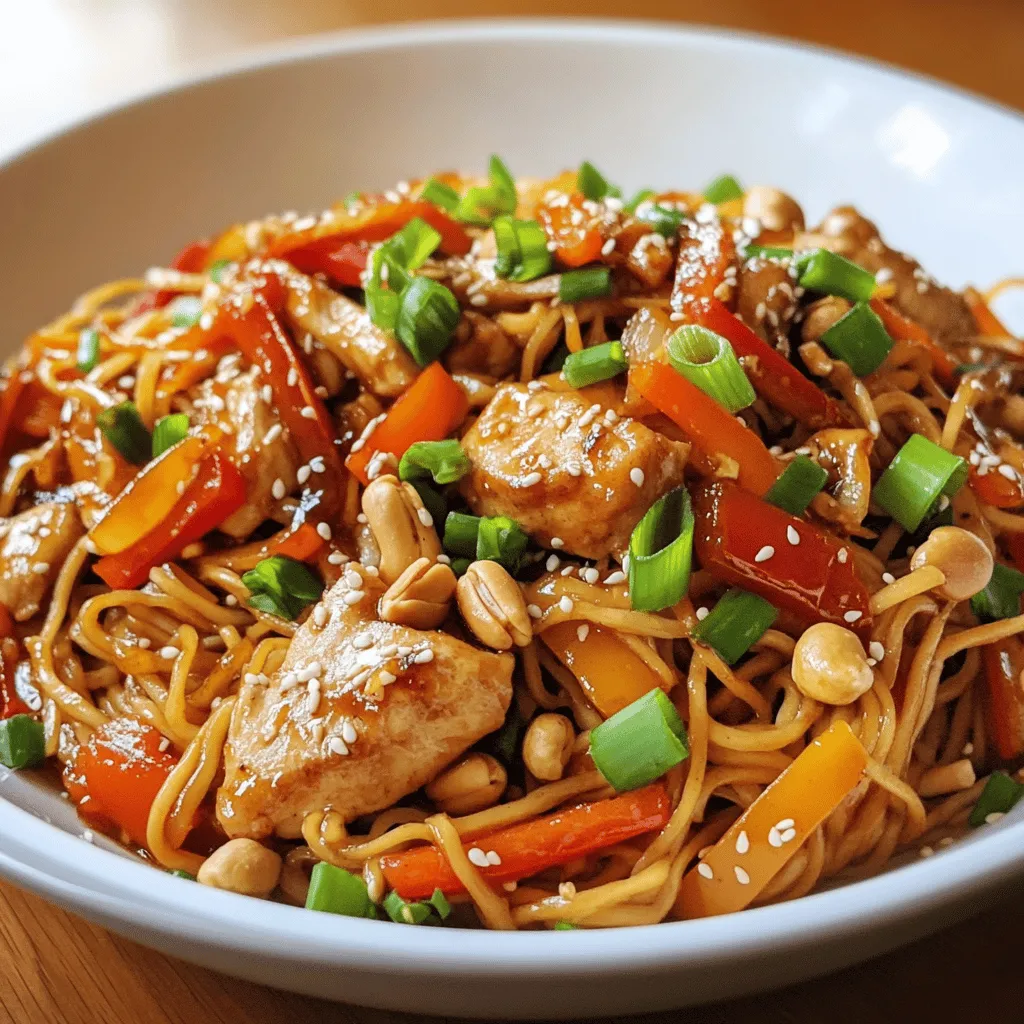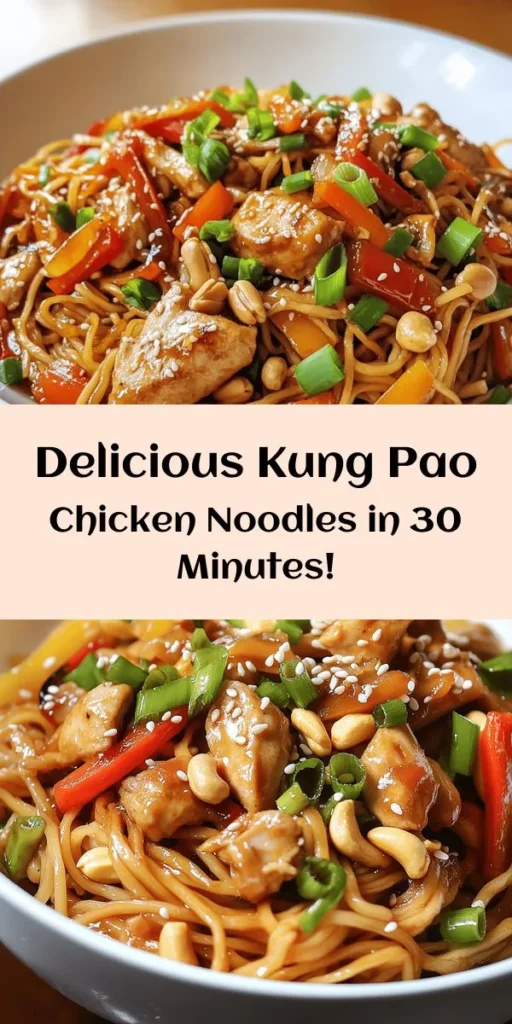Introduction
Kung Pao Chicken Noodles is a beloved dish that perfectly encapsulates the essence of Chinese cuisine—vibrant flavors, fresh ingredients, and a delightful fusion of textures. This dish is not only a staple in Chinese households but has also gained popularity across the globe, making it a favorite among both home cooks and culinary enthusiasts. The combination of tender chicken, crunchy vegetables, and nutty toppings creates an irresistible stir-fry that is both satisfying and nourishing.
What makes Kung Pao Chicken Noodles particularly appealing is its balance of flavors—sweet, salty, spicy, and savory. This harmony is achieved through careful ingredient selection and preparation techniques that elevate the dish from a simple stir-fry to an extraordinary culinary experience. This article aims to provide a comprehensive guide to making Kung Pao Chicken Noodles from scratch, ensuring that you achieve authentic flavors and textures with every bite.
Understanding Kung Pao Chicken Noodles
The Origin and History of Kung Pao Chicken
Kung Pao Chicken, known as “Gong Bao Ji Ding” in Mandarin, has a rich history that dates back to the late 19th century in the Sichuan province of China. The dish is named after a Qing Dynasty governor, Ding Baozhen, who was fond of this spicy stir-fry. Traditionally, Kung Pao Chicken features diced chicken cooked with peanuts, vegetables, and a distinctive sauce that includes Sichuan peppercorns, giving it a unique numbing spiciness.
Over the years, Kung Pao Chicken has evolved to suit various regional tastes and cooking styles. The introduction of noodles into this classic dish represents a delightful fusion, transforming it into a hearty meal that combines the rich flavors of the original recipe with the satisfying texture of noodles.
The Evolution into Noodle Stir-Fry
The transition from Kung Pao Chicken to Kung Pao Chicken Noodles marks a significant evolution in how this dish is enjoyed. Adding noodles not only enhances the dish’s heartiness but also provides a vehicle for the savory sauce and tender chicken. This variation is particularly popular in Western adaptations, where the inclusion of noodles caters to a broader palate and adds a comforting element to the meal.
The key to mastering Kung Pao Chicken Noodles lies in balancing the distinct flavors present in the original Kung Pao Chicken. The interplay of sweetness from the sauce, saltiness from the soy sauce, the heat of the chili peppers, and the savory notes from the chicken creates a complex flavor profile that is both exciting and satisfying.
The Importance of Balancing Flavors
To achieve the perfect Kung Pao Chicken Noodles, understanding the importance of flavor balance is crucial. The dish should present a delightful medley of sweet, salty, spicy, and savory notes. Each ingredient contributes to this balance:
– Sweetness: Typically derived from hoisin sauce or sugar, balancing the heat and saltiness.
– Saltiness: Soy sauce is essential for seasoning the chicken and enhancing the overall umami flavor.
– Spiciness: Dried chili peppers or chili paste add heat, which can be adjusted according to personal preference.
– Savory Elements: Chicken, along with the vegetables, adds depth and richness to the dish.
By carefully measuring and adjusting these components, home cooks can create a personalized version of Kung Pao Chicken Noodles tailored to their taste preferences.
Ingredients Breakdown
Creating Kung Pao Chicken Noodles requires a thoughtful selection of ingredients, each playing a vital role in achieving the dish’s signature flavor and texture. Here’s a breakdown of the essential components:
Egg Noodles
Egg noodles are the base of this dish, providing a chewy texture that complements the tender chicken and crunchy vegetables. Their slightly rich flavor enhances the overall taste of the stir-fry. When cooked properly, egg noodles absorb the sauce beautifully, ensuring that every bite is packed with flavor. Opt for fresh egg noodles when available, as they offer a superior texture compared to dried varieties.
Chicken Breast
The choice of protein is crucial for a satisfying Kung Pao Chicken Noodles dish. Chicken breast is the traditional option, prized for its lean meat and ability to absorb flavors during marination. For the best results, marinate the chicken in a mixture of soy sauce, cornstarch, and a splash of rice wine or vinegar. This not only enhances the flavor but also helps to keep the chicken tender during cooking.
Sauces: Soy Sauce, Hoisin Sauce, and Rice Vinegar
The trio of sauces—soy sauce, hoisin sauce, and rice vinegar—creates the rich and complex flavor profile characteristic of Kung Pao Chicken. Soy sauce serves as the primary seasoning, while hoisin sauce adds sweetness and depth. Rice vinegar introduces a subtle tanginess, balancing the flavors and enhancing the overall taste. Together, these sauces create a harmonious blend that elevates the dish.
Vegetables
A colorful assortment of vegetables is essential for not only aesthetics but also nutrition. Bell peppers, zucchini, and carrots are commonly used, providing crunch and vibrant color. These vegetables also contribute fiber and vitamins, making the dish more wholesome. Feel free to experiment with seasonal vegetables or your favorites to personalize the stir-fry.
Nuts: Peanuts or Cashews
Nuts are a key ingredient in Kung Pao Chicken, adding a delightful crunch and richness to the dish. Traditionally, roasted peanuts are used; however, cashews can also be a delicious alternative. They provide healthy fats and additional texture, enhancing the overall eating experience. Toasting the nuts before adding them to the stir-fry amplifies their flavor, making them an irresistible topping.
Preparation Steps
Now that we have a clear understanding of the ingredients, let’s dive into the detailed preparation steps that will guide you in making the perfect Kung Pao Chicken Noodles.
Cooking the Noodles
The first step in preparing Kung Pao Chicken Noodles is cooking the egg noodles to perfection. Here’s how to do it:
1. Boil Water: Fill a large pot with water and bring it to a rolling boil. Adding a pinch of salt can enhance the flavor of the noodles.
2. Add Noodles: Once the water is boiling, add the egg noodles. Stir them gently to prevent sticking and ensure even cooking.
3. Cooking Time: Follow the package instructions for cooking time, typically 3-5 minutes for fresh egg noodles. Taste a strand to ensure they are cooked al dente—cooked through but still firm to the bite.
4. Drain and Rinse: Once cooked, drain the noodles in a colander and rinse them under cold water. This step stops the cooking process and prevents the noodles from becoming mushy.
5. Toss with Oil: To keep the noodles from sticking together, toss them with a drizzle of sesame oil or vegetable oil after rinsing.
Marinating the Chicken
Marinating the chicken is a crucial step that infuses the meat with flavor and tenderizes it. Here’s how to prepare the chicken breast for your stir-fry:
1. Prepare the Marinade: In a bowl, combine soy sauce, cornstarch, and a splash of rice wine or vinegar. The cornstarch acts as a tenderizer and creates a slight coating on the chicken, which will help lock in moisture during cooking.
2. Cut the Chicken: Slice the chicken breast into bite-sized pieces, ensuring uniformity for even cooking.
3. Marinate: Add the chicken pieces to the marinade, mixing well to ensure each piece is coated. Allow the chicken to marinate for at least 15-30 minutes. For more flavor, marinate it for a few hours or overnight in the refrigerator.
Preparing the Sauce
The sauce is the heart of Kung Pao Chicken Noodles, and preparing it correctly is essential for achieving the dish’s signature taste. Here’s a step-by-step guide:
1. Combine Ingredients: In a small bowl, whisk together soy sauce, hoisin sauce, rice vinegar, and a bit of sugar. Adjust the proportions according to your taste preference, keeping in mind the balance of sweet, salty, and tangy flavors.
2. Add Spice: For a spicy kick, consider adding chili paste or a few crushed dried chili peppers to the sauce. Be cautious with the quantity, as the spice levels can quickly escalate.
3. Thicken the Sauce: If you prefer a thicker sauce, add a teaspoon of cornstarch mixed with a tablespoon of water. This will give the sauce a glossy finish and help it cling to the noodles and chicken.
4. Taste and Adjust: Before cooking, taste the sauce and make any necessary adjustments. A well-balanced sauce is critical for the overall success of the dish.
With these preparation steps completed, you’re well on your way to creating a delicious serving of Kung Pao Chicken Noodles. In the next section, we will outline the cooking process, bringing all these elements together for a delightful stir-fry experience.

Stir-frying Techniques: Tips for Achieving the Perfect Stir-Fry
Stir-frying is a quintessential technique in Chinese cuisine, and perfecting it is key to achieving the ideal texture and flavor in your Kung Pao Chicken Noodles. Here are some essential tips to ensure your stir-fry comes out perfectly every time:
1. Prep Everything in Advance: Before you even turn on the heat, have all your ingredients prepped and ready to go. This includes chopping your vegetables, marinating the chicken, and measuring out sauces. Stir-frying happens quickly, and you don’t want to be scrambling for ingredients mid-cook.
2. Use High Heat: The hallmark of a great stir-fry is high heat. This allows for quick cooking, which preserves the nutrients and textures of your ingredients. Make sure your wok or skillet is preheated until it’s hot enough that a few drops of water sizzle and evaporate immediately.
3. Choose the Right Oil: Opt for oils with high smoke points such as peanut oil or vegetable oil. These oils can withstand the high temperatures needed for stir-frying without burning.
4. Don’t Overcrowd the Pan: When you add too many ingredients at once, you lower the pan’s temperature, leading to steaming instead of stir-frying. Cook in batches if necessary. Start with the chicken, remove it once cooked, and then add the vegetables.
5. Stir Constantly: Keep the ingredients moving in the pan. This ensures even cooking and prevents any one ingredient from becoming overcooked or burnt. Use a spatula to flip and toss the ingredients regularly.
Combining Ingredients: Ensuring Even Distribution of Flavors and Textures
Once your ingredients are prepped and your stir-fry is underway, it’s essential to combine them properly to achieve a harmonious balance of flavors and textures. Here’s how to do it effectively:
1. Layering Technique: Start with the protein (chicken) first, allowing it to brown before adding the vegetables. This not only enhances flavor but also creates a layer of taste that will infuse the other ingredients, especially once you add the sauce.
2. Add Vegetables by Hardness: Introduce vegetables based on their cooking times. For example, add carrots and bell peppers first since they take longer to cook, followed by quicker-cooking vegetables like bell peppers and green onions. This ensures that everything is cooked just right, maintaining crispness in the veggies.
3. Sauce Timing: Once your chicken and vegetables are cooked to your liking, add the sauce mixture. This allows the flavors to meld together while also giving the ingredients a glossy finish. Make sure to toss everything well to ensure each piece is coated evenly.
4. Final Touches: After the sauce has thickened slightly, finish off with any fresh herbs or nuts (like roasted peanuts or cashews) to add a crunchy texture and enhance the flavor profile.
Serving Suggestions: Presentation Tips to Elevate the Dish
Presentation is key when serving Kung Pao Chicken Noodles, as it enhances the dining experience. Here are some tips to make your dish visually appealing:
1. Choose the Right Dish: Use a wide, shallow bowl or a large serving platter. This allows the ingredients to be spread out nicely, showcasing the vibrant colors of the veggies and noodles.
2. Garnish Thoughtfully: Fresh herbs like cilantro or green onions add a pop of color and freshness. A sprinkle of sesame seeds or crushed peanuts can also provide a delightful crunch and visual interest.
3. Serve with Sides: Pair your dish with garnishes such as lime wedges, additional chopped peanuts, or a side of pickled vegetables. These add depth to the meal and allow diners to customize their experience.
4. Create Height: When plating, stack the noodles slightly and place the chicken and vegetables on top. This adds height to the dish, making it more visually appealing.
Nutritional Analysis
Understanding the nutritional content of the Kung Pao Chicken Noodles can help you make informed choices. Here’s a breakdown of the nutritional content per serving, along with the health benefits of key ingredients:
– Calories: Approximately 400-500 calories per serving, depending on the quantity of oil and sauce used.
– Protein: Around 30 grams, largely from the chicken, providing essential amino acids for muscle repair and growth.
– Fats: Approximately 15-20 grams, primarily from the cooking oil and nuts, contributing to heart health when consumed in moderation.
– Carbohydrates: Roughly 50-60 grams from the noodles and vegetables, offering a source of energy and dietary fiber.
Health Benefits of Key Ingredients:
– Lean Protein: Chicken is a great source of lean protein, which aids in weight management and muscle development.
– Vegetables: Bell peppers, carrots, and green onions are rich in vitamins A and C, antioxidants, and dietary fiber that support overall health.
– Healthy Fats: Nuts like peanuts not only add crunch but also provide healthy fats and protein, making the dish more satisfying.
Allergen Considerations:
– Nuts: Peanuts are a common allergen; consider omitting them or substituting with sunflower seeds for those with nut allergies.
– Gluten: Traditional soy sauce contains gluten. Opt for gluten-free soy sauce to accommodate those with gluten sensitivities.
Variations and Customizations
Kung Pao Chicken Noodles are inherently versatile. Here are some suggestions for ingredient substitutions and customizations based on personal preferences or dietary needs:
1. Protein Alternatives: For those avoiding chicken, tofu is an excellent vegetarian substitute. It absorbs flavors well and provides a protein boost. Shrimp or beef can also be used for a different flavor profile.
2. Vegetarian Sauce Options: Use gluten-free soy sauce or tamari for a gluten-free version. You can also explore mushroom-based sauces for a rich umami flavor without the meat.
3. Adjusting Spice Levels: The level of heat can be adjusted based on your palate. If you prefer a milder dish, reduce the number of dried chili peppers or omit them altogether. Conversely, for a spicier version, consider adding fresh chili or chili paste.
4. Incorporating Seasonal Vegetables: Take advantage of fresh, seasonal produce to keep the dish exciting. Snow peas in the spring or broccoli in the winter can add freshness and variety.
Cultural Significance
Kung Pao Chicken is not just a dish; it embodies a rich cultural heritage that reflects the principles of balance and harmony in Chinese cuisine. Originating from the Sichuan province, this dish combines sweet, sour, salty, and spicy flavors, showcasing the complexity of Chinese culinary traditions.
In Chinese culture, meals are often centered around balance, both in taste and nutrition. The incorporation of various ingredients in Kung Pao Chicken Noodles illustrates this philosophy, as it harmoniously blends different textures and flavors. Its popularity has transcended borders, with adaptations seen across the globe, particularly in Western Chinese restaurants.
These adaptations often cater to local tastes, making Kung Pao Chicken a beloved dish worldwide. From its traditional roots to modern interpretations, this dish exemplifies the adaptability and enduring appeal of Chinese cuisine.
Conclusion
In summary, making Kung Pao Chicken Noodles is not just about following a recipe; it’s about understanding the techniques, flavors, and cultural significance behind the dish. From mastering stir-frying techniques to knowing how to combine ingredients for maximum flavor, each step contributes to the final masterpiece.
This dish’s versatility ensures that it can cater to various dietary preferences while still delivering an explosion of flavors. We encourage you to experiment with different ingredients, share the experience with friends and family, and make this delightful recipe your own. Whether it’s a cozy weeknight dinner or a gathering with loved ones, Kung Pao Chicken Noodles are sure to impress and satisfy. Enjoy your culinary journey!



